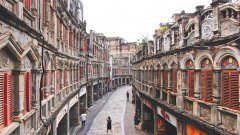Feature: Poverty-stricken Gazans yearn for better living in
Osama Radi, Omar Alothmani
GAZA, Sept. 11 (Xinhua) -- Being unable to afford a sacrificial animal for Muslim's Eid al-Adha feast, Mohammed Hadido, a Palestinian from the poverty-stricken Gaza Strip, purchased a share of a cow instead.
"This is the only way I could follow the Islamic ritual," the man in his 40s said. "The dire economic conditions of Gaza have prevented me from sacrifice during the feast for the past three years."
Eid al-Adha, the feast of sacrifice, is celebrated by Muslims worldwide in memory of Prophet Abraham's near-sacrifice of his own son as ordered by God.
Palestinians in Gaza have adopted the sharing system during the sacrifice feast in recent years due to the worsening financial situation of the majority of the population.
This year, consumers can still buy shares in a cow or a calf and can pay on installments after agreeing with livestock merchants.
"I bought one share in a cow for 1,500 Israeli Shekels (about 400 U.S. dollars). I will pay the money on installments during the coming 10 months," Hadidi told Xinhua as he was checking the cow he and five of his friends have shared.
Only rich people can afford buying a sacrifice in a community that suffers from high rate of unemployment and more than half of the residents live under the poverty line.
Gaza has been placed under a tight Israeli blockade since Hamas movement seized the territory by force in 2007.
The blockade has pushed Gaza's 1.9 million populations deeper into poverty as unemployment rate hit 42.7 percent, according to official figures.
According to international organizations and United Nations agencies, over 60 percent of the people in Gaza live in food insecurity as hundreds of thousands rely on foreign food aid.
A report of World Bank said the Gaza Strip ranks third across the Arab region in terms of poverty rates after Sudan and Yemen.
Although prices of sacrificial animals have down this year, the purchasing power has been low due to the ailing economy of the blockaded seaside territory.
Livestock traders have been eagerly waiting for the holy feast to sell their cattle. But the poverty of most of Gaza's population and the closure blocked their hopes of a better season.
Cattle trader Mohanned Abu Ajwa feels frustrated as most of the cows and calves he imported have not been sold yet.
"Only wealthy people buy animals for the feast," Abu Ajwa said. "Now we follow the installment system to sell out our animals, otherwise they will stay at the barn and we will lose money for feeding them."
The trader, whose farm was destroyed during the recent Israel war on Gaza in 2014, added that most of the livestock are imported from Europe and entered Gaza through Israel, adding that Gaza's local production of livestock during the past three years covered 40 percent of the local market needs.
"But the rising prices of food for animals have led traders to prefer to import the livestock from abroad since this will cost less."
According to Gaza's Ministry of Agriculture, there are 17,000 calves and cows and 30,000 to 40,000 sheep and goats all over the strip, with the majority of them imported.
The ministry said the purchasing ability this year is acceptable in Gaza amid the deteriorating conditions of economy. The Gaza Strip has witnessed three major devastating wars in the past seven years.















